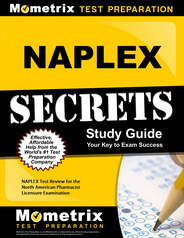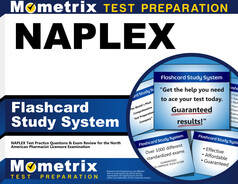The North American Pharmacy Licensure Examination (NAPLEX) is not given very often, it takes years of expensive schooling to qualify for, and the testing fee is around $500 every time a person takes it. For all these reasons, and many more, it is imperative that you be fully prepared for the exam so that you can pass it on your first attempt. Failure can be a very expensive setback because it can prevent you from embarking on a lucrative pharmacy career for months. Fortunately, there are several things a person can do to be fully prepared for this challenging and rigorous test. Fully understanding the test is the first step toward passing it.
The NAPLEX Competency Statements are one of the keys to having a complete understanding of what the examination designers are looking for. On a regular basis, the National Association of the Boards of Pharmacy (NABP) conducts a NAPLEX blueprint review, in which pharmacists and experts from across America get together to establish new benchmarks for the levels of knowledge and performance a pharmacist is expected to possess.
These new standards are then broken down into several components, which are then expressed as Competency Statements. Currently, the three sections of the exam are broken down into over three dozen individual components. Reviewing and even memorizing these components will be very helpful when it comes to understanding what you need to brush up on for the exam. While we can’t list them all here, you can find them on the website of the National Association of the Boards of Pharmacy, at nabp.net.
Another way of making absolutely sure you’re ready for the exam is to rely on a well written study guide and other study aids. These come in many different forms and range widely in price, and every year thousands of people turn to them for help in preparing for the NPLEX. This popularity is evidence of their effectiveness. If they didn’t help test takers improve, results would get around fast, and people would quit buying them. Of course, how effective they are is totally up to the user, who must actually put them into practice in order to better understand the exam.
Finally, the NABP publishes a practice test called the Pre-NAPLEX. The exam is much like the actual NAPLEX, but shorter, and taking it will reveal much about your strengths and weaknesses. The current cost of the exam is $50, and it can be taken wherever you have access to the internet. You’re allowed to take it no more than twice. For those concerned about their prospects of passing the exam on the big day, taking the practice exam is an excellent idea.
NAPLEX Study Guide
Explore our free NAPLEX review provided by Mometrix. Check out our premium NAPLEX study guide to take your studying to the next level. If you benefit from these materials, just click the link below! To compliment our NAPLEX book, we also offer extensive NAPLEX flashcards for even more NAPLEX test prep help. We hope you enjoy our products! Your purchase helps us make more great, free NAPLEX certification content for test-takers just like yourself.
NAPLEX Practice Questions
1. Your patient weighs 140 lbs. He requires 80 units/kg heparin bolus, followed by 18 units/kg/hour infusion. What is the correct bolus dose and infusion rate?
- 11,000 unit bolus; 2,500 units/hr
- 6,000 unit bolus; 2,000 units/hr
- 5,000 unit bolus; 550 units/hr
- 5,000 unit bolus; 1,100 units/hr
- 2,500 unit bolus; 1,100 units/hr
2. The nurse adds 20 mEq of KCl (2 mEq/mL) to a 110 mL bag of D5W and delegates you to infuse the piggyback over 1 hour. What is the infusion rate in drops/min if the drug is administered using an infusion set that delivers 15 drops/mL?
- 15 gtt/min
- 28 gtt/min
- 30 gtt/min
- 33 gtt/min
- 60 gtt/min
3. Which statement regarding phase II clinical trials is TRUE?
I. Phase II determines drug pharmacokinetics
II. Phase II determines dose range
III. Phase II determines LD50
- I only
- III only
- I and II
- II and III
- I, II, and III
4. What is the osmolarity of 5% sodium bicarbonate in mOsm/L? (p198 pcalc/446 kap)
MW=84 mg i=1.8
- 1.07 mOsm/L
- 10.7 mOsm/L
- 107 mOsm/L
- 1,071 mOsm/L
- 10,714 mOsm/L
5. Which pairing is NOT an example of a contraindicated drug combination?
- amiodarone (Cordarone) / ibutilide (Covert)
- isosorbide dinitrate (Isordil) / tadalafil (Cialis)
- phenelzine (Nardil) / meperidine (Demerol)
- methysergide (Sansert) / rizatriptan (Maxalt)
- theophylline (Theo-Dur) / cimetidine (Tagamet)
Answers and Explanations
1. D: Convert 140 pounds to metric weight by dividing 140 by 2.2, and the patient weighs approximately 63.6 kilograms. Therefore, his heparin bolus should be about 5,000 units and the infusion rate about 1,100 units/hr.
2. C: 120 mL/ 60 min x 15 gtt/mL = 30 gtt/min
3. C: A phase I clinical trial is the first trial during which an experimental agent is given to humans. The goals of a phase I trial include determining the safe dose range, adverse effects, pharmacokinetics, and efficacy of the experimental drug. A phase II clinical trial determines whether the drug works and should be further tested, its adverse effects, pharmacokinetics, and therapeutic dose. A phase III clinical trial compares this new treatment to a standard treatment. The LD50 (lethal dose 50%) is only performed in animal trials.
4. D: 1,071 mOsm/L
5 mg x 1 mol x 1,000 mmol x 1.8 mOsm x 1,000 mL
100 mL 84 mg mol mmol L
= 9,000,000 mOsm = 1,071 mOsm/L 8,400 L
5. E: Therapeutic concentrations of amiodarone and ibutilide prolong the Q-Tc interval on an electrocardiogram, so do not administer them concomitantly. Do not administer nitrates with phosphodiesterase inhibitors because they markedly increase hypotension. Do not coadminister nonselective MAOIs with serotonergic drugs, due to the risk of serotonin syndrome. Do not coadminister ergotamines with triptans, because they cause extreme vasoconstriction. Inhibitors of CYP1A2 (and CYP3A4, to a lesser extent) may increase theophylline levels. Cimetidine with theophylline is not contraindicated, but consider safer alternatives. Monitor your patient’s signs, symptoms, and blood levels for theophylline toxicity .




